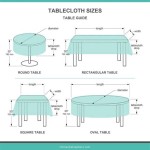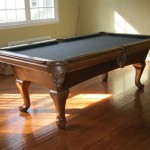Average Dining Table Dimensions: A Comprehensive Guide
Selecting the right dining table involves careful consideration of various factors, including available space, seating requirements, and desired aesthetic. A crucial aspect of this selection process is understanding average dining table dimensions. Choosing a table that is either too large or too small can negatively impact both the functionality and the overall ambiance of the dining area. This article provides a comprehensive guide to average dining table dimensions, exploring different shapes, sizes, and factors to consider when choosing the appropriate table for a particular space.
The average dining table dimensions are not fixed values. They vary depending on the shape of the table, the number of individuals it is intended to accommodate, and the general design principles applied in furniture manufacturing. However, certain standard dimensions serve as guidelines for both manufacturers and consumers. Understanding these averages allows for informed decisions when purchasing or designing a dining table.
Standard Dimensions for Rectangular Dining Tables
Rectangular dining tables are among the most common choices for dining rooms due to their versatility and ability to accommodate a larger number of individuals. The average dimensions for rectangular tables typically depend on the number of seats required. A small rectangular table designed for two individuals usually measures around 36 inches in length and 30 inches in width. This size provides adequate space for two diners without overwhelming smaller dining areas.
For a rectangular table intended to seat four individuals, the average dimensions increase to approximately 48 inches in length and 36 inches in width. This size allows each diner sufficient personal space while maintaining a comfortable proximity for conversation. Tables designed to seat six individuals commonly measure around 60 to 72 inches in length and 36 to 40 inches in width. These dimensions provide ample space for each individual, as well as room for serving dishes in the center of the table.
Larger rectangular tables intended for eight or more individuals typically measure 72 inches to 96 inches or more in length, with a width ranging from 40 to 48 inches. These dimensions are suitable for larger dining rooms and families who frequently host gatherings. It is important to consider the available space in the dining room when selecting a rectangular table of this size, ensuring sufficient clearance around the table for comfortable movement.
The height of rectangular dining tables is generally standardized at around 28 to 30 inches. This height is considered optimal for comfortable dining, allowing individuals to sit with their arms at a natural level for eating. This standard height is consistent across various table sizes, ensuring ergonomic comfort regardless of the table's length and width.
Typical Dimensions for Round Dining Tables
Round dining tables offer a more intimate dining experience and are often preferred in smaller dining areas or for spaces where a more conversational atmosphere is desired. The dimensions of round dining tables are typically determined by their diameter, with the appropriate diameter varying based on the number of individuals it is intended to seat.
A small round dining table designed for two individuals usually has a diameter of around 30 to 36 inches. This size provides adequate space for two diners while maintaining a close proximity for conversation. It's a suitable option for apartments or breakfast nooks.
For a round table intended to seat four individuals, the average diameter increases to approximately 42 to 48 inches. This diameter allows each diner sufficient personal space and room for plates and glassware. This is a common size for smaller families or couples who occasionally entertain.
Round tables designed to seat six individuals commonly have a diameter of around 54 to 60 inches. This diameter provides a comfortable dining experience for each individual, with ample space for serving dishes in the center of the table. This size is often chosen for medium-sized dining rooms where a sense of intimacy is desired.
Larger round tables intended for eight or more individuals typically have a diameter of 60 inches or more. However, round tables of this size can be less practical, as they can make conversation across the table difficult. For larger groups, rectangular or oval tables are often preferred for their ability to accommodate more individuals while maintaining a more accessible conversational dynamic. As with rectangular tables, the standard height for round dining tables is generally around 28 to 30 inches.
Considerations for Square and Oval Dining Tables
Square dining tables are less common than rectangular or round tables but can be suitable for smaller spaces designed to seat four individuals. The average dimensions for a square dining table designed for four people are typically around 36 to 48 inches per side. A square table smaller than 36 inches may feel cramped, while one larger than 48 inches can occupy too much space and hinder conversation between diners.
Oval dining tables offer a compromise between the rectangular and round shapes, providing the elongated shape of a rectangular table while maintaining the softer edges of a round table. This shape can be particularly useful in narrow dining rooms, as it allows for easier movement around the table. The dimensions of oval dining tables vary depending on the number of individuals they are intended to seat.
An oval table intended to seat four individuals might measure approximately 48 inches in length and 36 inches in width, similar to a small rectangular table. For six individuals, the dimensions might increase to around 60 to 72 inches in length and 40 inches in width. Larger oval tables designed to seat eight or more individuals can measure 72 inches to 96 inches or more in length, with a width ranging from 40 to 48 inches.
One of the key advantages of an oval table is its ability to accommodate more individuals than a rectangular table of similar dimensions. The rounded ends allow for additional seating without making the table feel overly crowded. As with other table shapes, the standard height for square and oval dining tables is typically around 28 to 30 inches.
Factors Influencing Dining Table Size Selection
Selecting the appropriate dining table size involves considering several factors beyond the number of individuals to be seated. The size of the dining room, the style of the space, and the intended use of the table all play a role in determining the optimal dimensions.
One crucial factor is the available space in the dining room. It is essential to measure the dimensions of the room and consider the placement of other furniture, such as sideboards or buffets. A general rule of thumb is to allow at least 36 inches of clearance between the edge of the dining table and any walls or other furniture. This clearance allows for comfortable movement around the table and prevents the space from feeling cramped.
The style of the dining room also influences the choice of table size and shape. In formal dining rooms, larger rectangular or oval tables are often preferred, as they convey a sense of elegance and grandeur. In more casual dining areas, smaller round or square tables may be more appropriate. The overall aesthetic of the space, including the color scheme and the style of the other furniture, should be considered when selecting a dining table to ensure a cohesive and harmonious look.
The intended use of the table is another important factor. If the table is primarily used for everyday family meals, a smaller table that comfortably seats the immediate family may be sufficient. However, if the table is frequently used for entertaining guests or hosting large gatherings, a larger table that can accommodate more individuals may be necessary. It is also important to consider whether the table will be used for other purposes, such as homework or crafts, as this may influence the size and shape required.
Extending dining tables offer a flexible solution for individuals who occasionally need to accommodate larger groups. These tables can be expanded when necessary and reduced in size when not in use, making them a practical choice for smaller dining rooms or apartments. Extending tables come in various shapes and sizes, with different mechanisms for extending the table surface. Some tables use leaves that are inserted into the center of the table, while others use drop-leaf or butterfly-leaf mechanisms.
The material of the dining table can also influence the perceived size and weight of the table. Tables made from heavier materials, such as solid wood or stone, may appear larger and more substantial than tables made from lighter materials, such as glass or metal. The choice of material should be carefully considered in relation to the overall style and décor of the dining room.
Finally, the height of the dining chairs should be considered in relation to the height of the dining table. The standard height for dining chairs is around 18 inches from the seat to the floor, which allows for a comfortable seating position at a table with a height of 28 to 30 inches. However, it is important to measure the height of the chairs and the table to ensure that there is sufficient legroom and that the overall dimensions are appropriate for comfortable dining. A difference of approximately 10 to 12 inches between the seat height and the table height is generally considered optimal.
Measuring Your Dining Space for Optimal Table Fit
Accurate measurement of the dining space is paramount to selecting a table that fits correctly. Begin by determining the overall dimensions of the room, noting the length and width. Also, take into account any architectural features, such as doorways, windows, and built-in cabinets, that may impact table placement.
Visualize the table's position within the room. Ideally, there should be a minimum of 36 inches (approximately 91 cm) of clearance between the edge of the table and any walls or other furniture. This allows for comfortable movement around the table and prevents the space from feeling cramped. For areas where people frequently pass, such as doorways, consider increasing the clearance to 48 inches (approximately 122 cm) for easier navigation.
To accurately visualize the table's footprint, use painter's tape to mark the proposed dimensions on the floor. This provides a visual representation of the table's size and allows for adjustment before making a purchase. Consider walking around the taped-off area to assess the ease of movement and ensure there is adequate space. This step is particularly important for oddly shaped rooms or spaces with limited square footage.
Factor in the space occupied by chairs. When measuring the clearance around the table, account for the chairs being pulled out for seating. The chairs should not obstruct walkways or impede movement. Consider using chairs with a smaller footprint or chairs that can be easily tucked under the table when not in use to maximize space.
Think vertically. While floor space is crucial, also consider the height of the table in relation to other elements in the room. The table should complement the overall proportions of the space and not overwhelm it. A taller table can make a small room feel even smaller, while a table that is too short can feel out of place in a larger room. Standard table height is generally between 28 and 30 inches (approximately 71-76 cm), but variations exist. Ensure the table height is comfortable for all users.

A Guide To Choosing The Ideal Dining Table Width

Standard Dining Table Dimensions Sizes With 9 Detailed Diagrams Homenish Height

What Is The Ideal Dining Table And Chair Height

Dining Table Height Chair

What Are Standard Table Heights

What Is The Ideal Dining Table And Chair Height

Pin By Oana Tiution On Dinning Room Dining Table Sizes 12 Person 6 Seater

Standard Dining Table Dimensions Sizes With 9 Detailed Diagrams Homenish

What Is The Ideal Dining Table And Chair Height
What Size Dining Table Seats 6 Quora








